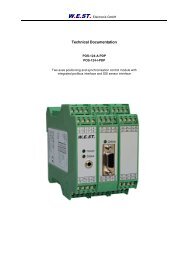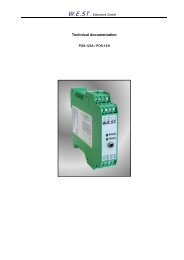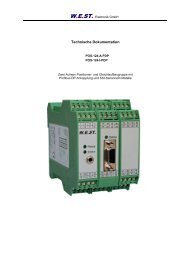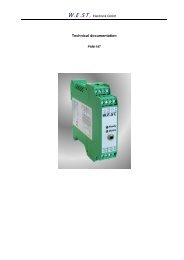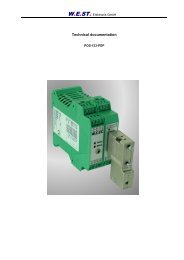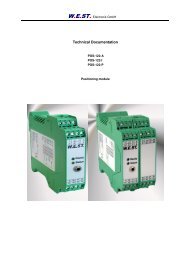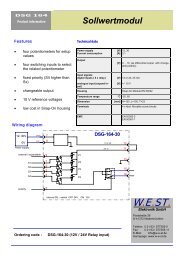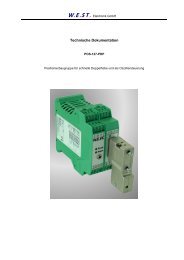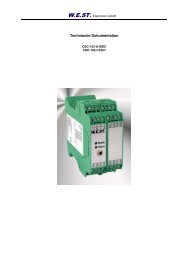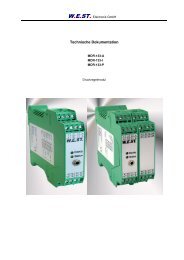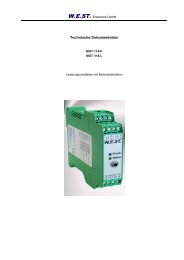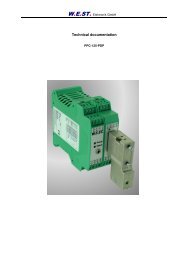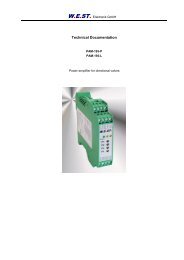Features - W.E.ST. Elektronische Steuerungen e. K.
Features - W.E.ST. Elektronische Steuerungen e. K.
Features - W.E.ST. Elektronische Steuerungen e. K.
You also want an ePaper? Increase the reach of your titles
YUMPU automatically turns print PDFs into web optimized ePapers that Google loves.
W.E.<strong>ST</strong>. Elektronik GmbH<br />
Technical Documentation<br />
DSG-111-A<br />
DSG-111-I<br />
DSG-111-P<br />
Digital demand value module, alternatively with power output stage
W.E.<strong>ST</strong>. Elektronik GmbH<br />
CONTENTS<br />
1 General Information .........................................................................................................................4<br />
1.1 Order number ................................................................................................................................4<br />
1.2 Scope of supply .............................................................................................................................4<br />
1.3 Accessories ...................................................................................................................................4<br />
1.4 Symbols used ................................................................................................................................5<br />
1.5 Using this documentation ..............................................................................................................5<br />
1.6 Legal notice ...................................................................................................................................5<br />
1.7 Safety instructions .........................................................................................................................6<br />
2 Characteristics .................................................................................................................................7<br />
2.1 Device description .........................................................................................................................8<br />
3 Use and application .........................................................................................................................9<br />
3.1 Installation instructions ..................................................................................................................9<br />
3.2 Typical system structure .............................................................................................................. 10<br />
3.3 Method of operation..................................................................................................................... 10<br />
3.4 Commissioning ............................................................................................................................ 11<br />
4 Technical description ..................................................................................................................... 12<br />
4.1 Input and output signals ............................................................................................................... 12<br />
4.2 LED definitions ............................................................................................................................ 13<br />
4.3 Block diagram ............................................................................................................................. 14<br />
4.4 Typical cabling ............................................................................................................................ 15<br />
4.5 Connection examples .................................................................................................................. 15<br />
4.6 Technical Data ............................................................................................................................ 16<br />
5 Parameters .................................................................................................................................... 17<br />
5.1 Parameter overview ..................................................................................................................... 17<br />
5.2 Parameter description ................................................................................................................. 18<br />
5.2.1 LG (Changing the language for the help texts)................................................................. 18<br />
5.2.2 MODE (Switching between parameter groups) ................................................................ 18<br />
5.2.3 DSEL (Deactivating S-Valid Input) ................................................................................... 18<br />
5.2.4 RMODE (ramp function) .................................................................................................. 19<br />
5.2.5 MF (linking of the external and internal command values)................................................ 19<br />
5.2.6 EOUT (Output signal: READY = OFF) ............................................................................. 20<br />
5.2.7 POL (output polarity) ....................................................................................................... 20<br />
5.2.8 SENS (sensor monitoring) ............................................................................................... 20<br />
5.2.9 AIN (Analogue input scaling) ........................................................................................... 21<br />
5.2.10 RW (Four-Quadrant-Ramp for the analogue input) .......................................................... 21<br />
5.2.11 S (command values of binary coded switch inputs).......................................................... 22<br />
5.2.12 RA (ramp times) .............................................................................................................. 22<br />
5.2.13 MIN (Deadband compensation) ....................................................................................... 23<br />
5.2.14 MAX (Limitation / Gain ) .................................................................................................. 23<br />
5.2.15 TRIGGER (Response threshold for the MIN parameter) .................................................. 23<br />
5.2.16 PROCESS DATA (Monitoring) ........................................................................................ 24<br />
6 Appendix ....................................................................................................................................... 25<br />
6.1 Failure monitoring ........................................................................................................................ 25<br />
6.2 Troubleshooting........................................................................................................................... 25<br />
6.3 Description of the command structure .......................................................................................... 26<br />
7 ADDITIONAL INFORMATION: Power output stage ........................................................................ 27<br />
Page 2 of 34 DSG-111*-*1121 23.04.2012
W.E.<strong>ST</strong>. Elektronik GmbH<br />
7.1 General function ..........................................................................................................................27<br />
7.2 Device description .......................................................................................................................28<br />
7.3 Inputs and outputs .......................................................................................................................29<br />
7.4 Circuit diagram ............................................................................................................................29<br />
7.5 Typical cabling.............................................................................................................................30<br />
7.6 Technical data .............................................................................................................................30<br />
7.7 Parameters ..................................................................................................................................31<br />
7.7.1 Parameter overview ........................................................................................................31<br />
7.8 Parameter description..................................................................................................................31<br />
7.8.1 CURRENT (Current range switchover) ............................................................................31<br />
7.8.2 DFREQ (Dither frequency) ..............................................................................................31<br />
7.8.3 DAMPL (Dither amplitude)...............................................................................................31<br />
7.8.4 PWM (PWM frequency) ...................................................................................................32<br />
7.8.5 PPWM (Solenoid current controller P element) ................................................................32<br />
7.8.6 IPWM (Solenoid current controller I element)...................................................................32<br />
8 Notes.............................................................................................................................................33<br />
Page 3 of 34 DSG-111*-*1121 23.04.2012
1 General Information<br />
1.1 Order number<br />
W.E.<strong>ST</strong>. Elektronik GmbH<br />
DSG-111-A-1121 1 - with analogue ± 10 V output<br />
DSG-111-I-1121 - with analogue 4… 20mA output<br />
DSG-111-P-1121 - (see additional information) with integrated power output stage up to 2,6 A<br />
Optional<br />
DSG-164 - 4 digital selectable demand values, scalable via potentiometers<br />
1.2 Scope of supply<br />
To the scope of supply belongs the module including the terminal blocks which are part of the housing.<br />
The Profibus plug, interface cables and further parts which may be required should be ordered<br />
separately. This documentation can be downloaded as a PDF file from www.w-e-st.de.<br />
1.3 Accessories<br />
RS232-SO - programming cable with RS232C interface<br />
USB-SO - programming cable with USB interface<br />
WPC-300 - Start-Up-Tool (downloadable – products/software)<br />
1 The number of the version consists of the hardware-version (first two digits) and the software-version (second two<br />
digits). Because of the development of the products these numbers can vary. They are not strictly necessary for the<br />
order. We will always deliver the newest version.<br />
Page 4 of 34 DSG-111*-*1121 23.04.2012
1.4 Symbols used<br />
General information<br />
Safety-related information<br />
1.5 Using this documentation<br />
Structure of the documentation:<br />
W.E.<strong>ST</strong>. Elektronik GmbH<br />
The standard product is descibed up to chapter 6. The extensions like POWER <strong>ST</strong>AGE or<br />
SSI-INTERFACE are described in the chapters ADDITIONAL INFORMATION.<br />
1.6 Legal notice<br />
W.E.St. Elektronik GmbH<br />
Poststraße 26<br />
D-41372 Niederkrüchten<br />
Tel.: +49 (0)2163 577355-0<br />
Fax.: +49 (0)2163 577355-11<br />
Home page: www.w-e-st.de or www.west-electronics.com<br />
EMAIL: info@w-e-st.de<br />
Date: 23.04.2012<br />
The data and characteristics described herein serve only to describe the product. The user is required to<br />
evaluate this data and to check suitability for the particular application. General suitability cannot be<br />
inferred from this document. We reserve the right to make technical modifications due to further<br />
development of the product described in this manual. The technical information and dimensions are nonbinding.<br />
No claims may be made based on them.<br />
This document is copyright.<br />
Page 5 of 34 DSG-111*-*1121 23.04.2012
1.7 Safety instructions<br />
W.E.<strong>ST</strong>. Elektronik GmbH<br />
Please read this document and the safety instructions carefully. This document will help to define the<br />
product area of application and to put it into operation. Additional documents (WPC-300 for the start-up<br />
software) and knowledge of the application should be taken into account or be available.<br />
General regulations and laws (depending on the country: e. g. accident prevention and environmental<br />
protection) must be complied with.<br />
These modules are designed for hydraulic applications in open or closed-loop control<br />
circuits. Uncontrolled movements can be caused by device defects (in the hydraulic<br />
module or the components), application errors and electrical faults. Work on the drive or<br />
the electronics must only be carried out whilst the equipment is switched off and not<br />
under pressure.<br />
This handbook describes the functions and the electrical connections for this electronic<br />
assembly. All technical documents which pertain to the system must be complied with<br />
when commissioning.<br />
This device may only be connected and put into operation by trained specialist staff. The<br />
instruction manual must be read with care. The installation instructions and the<br />
commissioning instructions must be followed. Guarantee and liability claims are invalid if<br />
the instructions are not complied with and/or in case of incorrect installation or<br />
inappropriate use.<br />
CAUTION!<br />
All electronic modules are manufactured to a high quality. Malfunctions due to the failure<br />
of components cannot, however, be excluded. Despite extensive testing the same also<br />
applies for the software. If these devices are deployed in safety-relevant applications,<br />
suitable external measures must be taken to guarantee the necessary safety. The same<br />
applies for faults which affect safety. No liability can be assumed for possible damage.<br />
Further instructions<br />
The module may only be operated in compliance with the national EMC regulations. It<br />
is the user’s responsibility to adhere to these regulations.<br />
The device is only intended for use in the commercial sector.<br />
When not in use the module must be protected from the effects of the weather,<br />
contamination and mechanical damage.<br />
The module may not be used in an explosive environment.<br />
To ensure adequate cooling the ventilation slots must not be covered.<br />
The device must be disposed of in accordance with national statutory provisions.<br />
Page 6 of 34 DSG-111*-*1121 23.04.2012
2 Characteristics<br />
W.E.<strong>ST</strong>. Elektronik GmbH<br />
This electronic module is designed to control hydraulic proportional valves. 16 programmable demand<br />
values are selectable by four digital switching inputs (binary coded).<br />
A ramp generator (4Q-ramps or 16 demand signal related ramps) allows flexible adjustments depending<br />
on the applications. A programmable function is linking the analogue input signal and the internal demand<br />
values together. MIN, MAX or scaling of the analogue input is possible.<br />
The adjustment via RS232C is simple and easy to understand. A standard terminal program or our special<br />
windows application software (WPC-300, download from our homepage) can be used.<br />
Typical applications: Rapid traverse and creeping speed, selectable velocities and pressure values, flow<br />
curve adjustments, ramp generation and analogue signal monitoring.<br />
<strong>Features</strong><br />
16 selectable demand values<br />
Four quadrant ramps or 16 selectable ramp times<br />
Analogue input and demand values are combinable with following functions:<br />
+, -, *, /, min, max<br />
Deadband compensation<br />
Parameter for valve adaptation (MIN, MAX, POL)<br />
Fault diagnosis and extended function checking<br />
Simplified parameterization with WPC-300 software version 3.2<br />
Optionally:<br />
o Integrated power output stage (P version)<br />
Page 7 of 34 DSG-111*-*1121 23.04.2012
2.1 Device description<br />
99,0000 mm<br />
Made in Germany<br />
Date: Add.:<br />
ID:<br />
V:<br />
W.E.<strong>ST</strong>. Elektronik<br />
D-41372 Niederkrüchten<br />
Homepage: http://www.w-e-st.de<br />
Typenschild und Anschlussbelegung<br />
Type plate and terminal pin assignment<br />
W.E.<strong>ST</strong>. Elektronik GmbH<br />
LEDs<br />
RS232<br />
Interface<br />
9 10 11 12<br />
13 14 15 16<br />
1 2 3 4<br />
5 6 7 8<br />
W.E.<strong>ST</strong>.<br />
Page 8 of 34 DSG-111*-*1121 23.04.2012<br />
Ready<br />
Status<br />
9 10 11 12<br />
13 14 15 16<br />
23,0000 mm<br />
114,0000 mm<br />
Klemmblöcke (steckbar)<br />
Terminals (removable)
3 Use and application<br />
3.1 Installation instructions<br />
W.E.<strong>ST</strong>. Elektronik GmbH<br />
This module is designed for installation in a shielded EMC housing (control cabinet). All cables<br />
which lead outside must be screened; complete screening is required. It is also necessary to<br />
avoid strong electro-magnetic interference sources being installed nearby when using our open<br />
and closed loop control modules.<br />
Typical installation location: 24 V control signal area (close to PLC)<br />
The devices must be arranged in the control cabinet so that the power section and the signal<br />
section are separate from each other.<br />
Experience shows that the installation place close to the PLC (24 V area) is most suitable. All<br />
digital and analogue inputs and outputs are fitted with filters and surge absorbers in the device.<br />
The module should be installed and wired in accordance with the documentation bearing in mind<br />
EMC principles. If other consumers are operated with the same power supply, a star-shaped<br />
ground wiring scheme is recommended. The following points must be observed when wiring:<br />
The signal cables must be laid separately from power cables.<br />
Analogue signal cables must be screened.<br />
All other cables must be screened if there are powerful interference sources (frequency<br />
converters, power contactors) and cable lengths > 3 m. Inexpensive SMD ferrites can<br />
be used with high-frequency radiation.<br />
The screening should be connected to PE (PE terminal) as close to the module as<br />
possible. The local requirements for screening must be taken into account in all cases.<br />
The screening should be connected to at both ends. Equipotential bonding must be<br />
provided where there are differences between the connected electrical components.<br />
If having longer lengths of cable (> 10 m) the diameters and screening measures should<br />
be checked by specialists (e. g. for possible interference, noise sources and voltage<br />
drop). Special care is required if using cables of over 40 m in length, and if necessary<br />
the manufacturer should be consulted if necessary.<br />
A low-resistance connection between PE and the mounting rail should be provided. Transient<br />
interference is transmitted from the module directly to the mounting rail and from there to the local<br />
earth.<br />
Power should be supplied by a regulated power supply unit (typically a PELV system complying<br />
with IEC364-4-4, secure low voltage). The low internal resistance of regulated power supplies<br />
gives better interference voltage dissipation, which improves the signal quality of high-resolution<br />
sensors in particular. Switched inductances (relays and valve coils) which are connected to the<br />
same power supply must always be provided with appropriate overvoltage protection directly at<br />
the coil.<br />
Page 9 of 34 DSG-111*-*1121 23.04.2012
3.2 Typical system structure<br />
W.E.<strong>ST</strong>. Elektronik GmbH<br />
This minimal system consists of the following components:<br />
(*1) Proportional valve (or control valve): the valve type determines the precision. It is expedient to<br />
use control valves with integrated electronics.<br />
(*2) Hydraulic cylinder (with servo seals)<br />
(*3) DSG-111-AI control module<br />
(*4) Interface to PLC with analogue and digital signals<br />
3.3 Method of operation<br />
This module can be used as a universal demand signal generator for different applications. The activation<br />
of the internal programmed demand values can be realized by the binary inputs. Alternatively, the activation<br />
of the demand values is also possible by the input S-VALID. Therefore, a synchronization with the<br />
PLC is not so difficult.<br />
Because of the mathematical combination of the internal demand value and the external analogue output<br />
there exists a further possibility to support signal adaptations.<br />
Consequently, this module is useful for signal adaptations, flow curve adjustments of control valves, rapid<br />
traverse and creeping speed with several selectable velocities and accelerations as well as a universal<br />
valve amplifier with integrated power amplifier.<br />
Page 10 of 34 DSG-111*-*1121 23.04.2012
3.4 Commissioning<br />
Step Task<br />
W.E.<strong>ST</strong>. Elektronik GmbH<br />
Installation Install the device in accordance with the circuit diagram. Ensure it is wired<br />
correctly and that the signals are well shielded. The device must be installed in a<br />
metal protective housing (control cabinet or similar).<br />
Switching on for the first<br />
time<br />
Ensure that no unwanted movement is possible in the drive (e. g. switch off the<br />
hydraulics). Connect an ammeter and check the current consumed by the device.<br />
If it is higher than specified there is an error in the cabling. Switch the device off<br />
immediately and check the cabling.<br />
Setting up communication Once the power input is correct the PC (notebook) should be connected to the<br />
serial interface. Please see the WPC-300 program documentation for how to set<br />
up communication.<br />
Further commissioning and diagnosis are supported by the operating software.<br />
Pre-parameterization Configure the settings specific to the actuator (MIN for the overlap compensation<br />
and MAX for maximum speed).<br />
Enter the desired set points in the parameter table.<br />
Control signal Check the control signal with a voltmeter. The control signal (PIN 15 to PIN16) lies<br />
in the range of ± 10 V. In the current state it should be 0 V. Alternatively, if current<br />
signals are used, approx. 0 mA should flow.<br />
Switching on the<br />
hydraulics<br />
The hydraulics can now be switched on. Since the module is not yet generating a<br />
signal the drive should be at a standstill or drift slightly (leave its position at a slow<br />
speed).<br />
Activating ENABLE CAUTION! The drive can now leave its position and move to an end position at<br />
full speed. Take safety measures to prevent personal injury and damage.<br />
Setpoint selection Now select from one of the inputs as a setpoint.<br />
Optimize controller Now optimize the controller parameters according to your application and your<br />
requirements.<br />
Page 11 of 34 DSG-111*-*1121 23.04.2012
4 Technical description<br />
4.1 Input and output signals<br />
Connection Supply<br />
W.E.<strong>ST</strong>. Elektronik GmbH<br />
PIN 3 Power supply (see technical data)<br />
PIN 4 0 V (GND) connection.<br />
Connection Analogue signals<br />
PIN 9/10 Analougue demand value (V), range 0… 100 % corresponds to 0… 10 V<br />
PIN 15/16 A Version: Differential output (U) ± 100 % corresponds to ± 10 V (0… 10 V at PIN 15 and<br />
PIN 16).<br />
I Version: ± 100 % corresponds to 4… 20 mA (PIN 15 to PIN 12).<br />
12 mA is the neutral position (0 % output signal).<br />
< 4 mA indicates that there is an error and the module has not been enabled. It must be<br />
ensured that the valve switches off at < 4 mA.<br />
Connection Digital inputs and outputs<br />
PIN 8 Enable input:<br />
This digital input signal initializes the application and error messages are deleted. The<br />
controller and the READY signal are activated. The output signal to the control element is<br />
enabled.<br />
The actual position is accepted as the command position and the drive remains stationary<br />
under control at this position. If the input is disabled, the output (control signal) is switched<br />
off(disabled). Take care off the EOUT-command!<br />
PIN 7 S-VALID input:<br />
The selected value (S1, S2, S4 and S8) will be activated by a signal change from low to<br />
high (DSEL = OFF).<br />
PIN 5<br />
PIN6<br />
PIN13<br />
PIN14<br />
Switching input:<br />
Binary selection of one of the 16 references. For direct selection of four set points<br />
can be parameterized as follows:<br />
PIN 5 = S:1 / RA:1<br />
PIN 6 = S:2 / RA:2<br />
PIN 14 = S:14 / RA:14<br />
PIN 13 = S:13 / RA:13<br />
PIN 1 READY output:<br />
ON: The module is enabled; there are no discernable errors.<br />
OFF: Enable (PIN 8) is disabled or an error (sensor or internal error) has been detected.<br />
Page 12 of 34 DSG-111*-*1121 23.04.2012
4.2 LED definitions<br />
W.E.<strong>ST</strong>. Elektronik GmbH<br />
LEDs Description of the LED function<br />
GREEN Identical to the READY output.<br />
OFF: no power supply or ENABLE is not activated<br />
YELLOW No function<br />
ON: System is ready for operation<br />
Flashing: Error discovered.<br />
Only active when SENS = ON.<br />
Page 13 of 34 DSG-111*-*1121 23.04.2012
4.3 Block diagram<br />
DSG-111A/I<br />
Internal Power<br />
3<br />
24 V<br />
24 V<br />
PELV<br />
0 V<br />
DC<br />
4<br />
DC<br />
0 V<br />
Differential<br />
Input<br />
W.E.<strong>ST</strong>. Elektronik GmbH<br />
Output Adaptation<br />
Link MF<br />
15<br />
Output: A (0..10)V<br />
Ramps<br />
Input Selektor<br />
w<br />
u<br />
9<br />
10<br />
Setpoint<br />
-10..10V<br />
16<br />
Commands:<br />
- MIN:A and :B<br />
- MAX:A and :B<br />
- TRIGGER<br />
- POL<br />
Commands:<br />
ADD, SUB,<br />
MUL, DIV,<br />
MIN, MAX,<br />
X, W<br />
w<br />
rw:i x<br />
i = 4<br />
x = 0..60000 ms<br />
Commando:<br />
AIN:W<br />
0 V<br />
Output: B (0..10)V<br />
11<br />
11<br />
I-Version 4... 20 mA<br />
PIN 15 = +<br />
PIN 11 = GND<br />
5<br />
Sel 1<br />
24 V in<br />
Page 14 of 34 DSG-111*-*1121 23.04.2012<br />
Command values<br />
Ramps<br />
6<br />
Sel 2<br />
ra:i x<br />
i = 1 | 2 | 3 | 4<br />
oder<br />
i = 0..15 (sel x)<br />
x = 0..60000 ms<br />
24 V in<br />
x<br />
s:i x<br />
i = 0..15<br />
x = -10000..10000<br />
14<br />
12<br />
Sel 4<br />
24 V in<br />
10 V Reference<br />
13<br />
Sel 8<br />
24 V in<br />
1<br />
Ready<br />
24 V out<br />
Control program<br />
7<br />
S-Valid<br />
24 V in<br />
Commands:<br />
- LG<br />
- MODE (Expert or Standard)<br />
- DSEL<br />
- EOUT (Error Mode)<br />
- RMODE<br />
PE via DIN-RAIL<br />
RS232 C<br />
9600 Baud<br />
1 Stopbit<br />
no parity<br />
8<br />
Enable<br />
24 V in<br />
3,5 mm JISC-6560 Jacket
4.4 Typical cabling<br />
4.5 Connection examples<br />
Joystick<br />
10V PIN 12<br />
+In PIN 9<br />
-In PIN 10<br />
GND PIN 11<br />
SPS / PLC 0... 10 V / +/- 10 V<br />
+In PIN 9<br />
-In PIN 10<br />
Valve (6 + PE plug) with OBE electronics<br />
Module<br />
Analogue CMD<br />
(-10V..10V)<br />
PIN 12<br />
PIN 15<br />
PIN 16<br />
24V switching outputs<br />
Status<br />
Ready<br />
24V switching inputs<br />
Enable<br />
Valid<br />
S 2<br />
S 1<br />
24V switching inputs<br />
S 8<br />
S 4<br />
A : 24 V supply<br />
B : 0 V supply<br />
C : GND or enable<br />
W.E.<strong>ST</strong>. Elektronik GmbH<br />
AIN:W 2000 1000 5000 V (für +/- 100%)<br />
AIN:W 1000 1000 0 V (für +/-100%)<br />
D : + differential input<br />
E : - differential input<br />
F : diagnostics<br />
PE -<br />
Screen<br />
PE Klemme<br />
1<br />
5<br />
9<br />
13<br />
2<br />
6<br />
10<br />
14<br />
3<br />
7<br />
11<br />
0V<br />
15<br />
4<br />
8<br />
12<br />
16<br />
PE Klemme<br />
Power supply<br />
Potentiometer / Joystick<br />
10V PIN 12<br />
+In PIN 9<br />
-In PIN 10<br />
GND PIN 11<br />
AIN:W 1000 1000 0 V (für 0... 100%)<br />
AIN:W 2000 1000 5000 V (für +/-100%)<br />
Page 15 of 34 DSG-111*-*1121 23.04.2012<br />
Screen<br />
24V<br />
0V<br />
PIN 12 = 10 V Reference output<br />
Proportional valve<br />
Differantial input should be used
4.6 Technical Data<br />
Power supply<br />
Current consumption<br />
External fuse<br />
Digital inputs<br />
Input resistance<br />
W.E.<strong>ST</strong>. Elektronik GmbH<br />
[VDC]<br />
[mA]<br />
Page 16 of 34 DSG-111*-*1121 23.04.2012<br />
[A]<br />
[V]<br />
[V]<br />
[kOhm]<br />
Digital outputs [V]<br />
[V]<br />
Analogue inputs (sensor and command signals)<br />
Resolution<br />
Speed input<br />
Analogue outputs<br />
Voltage<br />
Signal Resolution<br />
Current<br />
Signal resolution<br />
[V]<br />
[mA]<br />
[%]<br />
[V]<br />
[%]<br />
[V]<br />
[mA]<br />
[%]<br />
[mA]<br />
[%]<br />
Controller Sample time [ms] 1<br />
Serial Interface<br />
12… 30 (incl. ripple)<br />
10<br />
25<br />
logic 0: < 2 V<br />
logic 1: > 12 V (50 mA)<br />
0...10; 25 kOhm<br />
4...20; 250 Ohm<br />
0,01 (internally 0,0031) incl. Oversampling<br />
0...10; 90 kOhm<br />
0,01<br />
2 x 0...10 (differential output)<br />
5 (max. load)<br />
0,024<br />
4...20 mA (I version); 390 Ohm max. load<br />
0,024<br />
RS 232C, 9600 … 57600 Baud, 1 stopbit,<br />
no parity, Echo Mode<br />
Housing Snap-On Module EN 50022<br />
Polyamide PA 6.6<br />
Weight [kg] 0,170<br />
Protection class<br />
Temperature range<br />
Storage temperature<br />
Humidity<br />
[°C]<br />
[°C]<br />
[%]<br />
Combustibility class V0 (UL94)<br />
IP20<br />
-20… 60<br />
-20… 70<br />
5 Parameters<br />
5.1 Parameter overview<br />
W.E.<strong>ST</strong>. Elektronik GmbH<br />
Command Default Unit Description<br />
LG GB - Changing language help texts.<br />
MODE <strong>ST</strong>D - Mode parameter.<br />
DSEL OFF - Selection of the use of the S-VALID input. If DSEL = ON the<br />
inputs SEL x will be directly used. In OFF mode, a positive signal<br />
change will activate the SEL x inputs.<br />
RMODE SD - Selection of the ramp function. 4Q is the four-quadrant-ramp,<br />
SD is the command value related ramp and SDR is a jerk reduced<br />
command value related ramp (only up to 5000 ms and<br />
DSEL OFF mode)<br />
MF X - Selection of the linking functions between w and x. See block<br />
diagram.<br />
EOUT 0 0,01 % Error output signal.<br />
POL + - Reversal of output polarity.<br />
SENS AUTO - Activation and disabling of internal monitoring functions.<br />
AIN:W<br />
A: 1000<br />
B: 1000<br />
C: 0<br />
X: V<br />
-<br />
-<br />
0,01 %<br />
-<br />
Analogue input scaling for W<br />
RW:1… 4 100 ms Ramp times for the Four-Quadrant-Ramp<br />
S0:0… 15 0 0,01 % Programmable demand values, selectable with the digital inputs<br />
RA:0… 15 100 ms Programmable ramp times<br />
MIN:A<br />
MIN:B<br />
MAX:A<br />
MAX:B<br />
0<br />
0<br />
10000<br />
10000<br />
0,01 %<br />
0,01 %<br />
0,01 %<br />
0,01 %<br />
Zero point setting /following error compensation.<br />
Maximum output signal limitation.<br />
TRIGGER 200 0,01 % Trigger threshold for activating the following error compensation<br />
(MIN).<br />
Page 17 of 34 DSG-111*-*1121 23.04.2012
5.2 Parameter description<br />
W.E.<strong>ST</strong>. Elektronik GmbH<br />
5.2.1 LG (Changing the language for the help texts)<br />
Command Parameters Unit Group<br />
LG x x= DE|GB - <strong>ST</strong>D<br />
Either German or English can be selected for the help texts.<br />
CAUTION: After changing the language settings the ID button (SPEED BUTTON) in the menu<br />
bar (WPC-300) must be pressed (module identification).<br />
5.2.2 MODE (Switching between parameter groups)<br />
Command Parameters Unit Group<br />
MODE x x= <strong>ST</strong>D|EXP - <strong>ST</strong>D<br />
This command changes the operating mode. Various commands (defined via <strong>ST</strong>D/EXP) are blanked out<br />
in Standard Mode. The commands in Expert Mode have a more significant influence on system behavior<br />
and should accordingly be changed with care.<br />
5.2.3 DSEL (Deactivating S-Valid Input)<br />
Command Parameters Unit Group<br />
DSEL x X= ON|OFF - EXP<br />
The command value activation will be switched over with the DSEL command.<br />
DSEL= OFF: A new command value (Bit combination via S* inputs) will be active after a signal change<br />
(low to high) at input S-VALID.<br />
DSEL= ON: A new command value is immediately active.<br />
Page 18 of 34 DSG-111*-*1121 23.04.2012
5.2.4 RMODE (ramp function)<br />
W.E.<strong>ST</strong>. Elektronik GmbH<br />
Command Parameters Unit Group<br />
RMODE X X= 4Q|SD|SDR - EXP<br />
Definition of the generated ramp function.<br />
RMODE= 4Q: A four-quadrant ramp is active. The related quadrant (RA:1 = ramp up at extending,<br />
RA:2 = ramp down at extending, RA:3 = ramp up at retracting and RA:2 = ramp down at<br />
retracting) is defined by the RA:1… RA:4.<br />
RMODE= SD: Command signal related ramp time. Depending on the input combination one of the 16<br />
ramp times is selected.<br />
RMODE= SDR: Jerk limited ramp time (see SD). This ramp function is used for smooth acceleration and<br />
deceleration of hydraulic axis. The max ramp time is limited by 5 s. This function can not<br />
be used with DESEL = ON.<br />
5.2.5 MF (linking of the external and internal command values)<br />
Command Parameters Unit Group<br />
MF X X= W|X|ADD|SUB<br />
MUL|DIV|MIN|MAX<br />
Via the linking of the analogue input (W) and the programmed command values (X) different calculations<br />
are possible.<br />
W: the analogue input is only used (W).<br />
X: the programmed input is only used (X).<br />
ADD: both values are added (W + X).<br />
SUB: both values are subtracted (X - W).<br />
MUL: both values are multiplied (W * X).<br />
DIV: X is divided by W (X / W)<br />
MAX: the higher value is taken over<br />
MIN: the lower value is taken over<br />
Page 19 of 34 DSG-111*-*1121 23.04.2012<br />
<strong>ST</strong>D
W.E.<strong>ST</strong>. Elektronik GmbH<br />
5.2.6 EOUT (Output signal: READY = OFF)<br />
Command Parameters Unit Group<br />
EOUT X x= -10000… 10000 0,01 % EXP<br />
Output value in case of a detected error or a deactive ENABLE input. A value (degree of valve opening)<br />
for use in the event of a sensor error (or the module is disabled) can be defined here. This function can<br />
be used if, for example, the drive is to move to one of the two end positions (at the specified speed) in<br />
case of a sensor error.<br />
|EOUT| = 0 The output is switched off in the event of an error. This is normal behavior.<br />
CAUTION! If the output signal is 4… 20 mA, the output is switched off when |EOUT| = 0. If a<br />
null value = 12 mA is to be output in the event of an error, EOUT must be set to 1 2 .<br />
The output value defined here is stored permanently (independently of the parameter set).<br />
The effects should be analyzed by the user for each application from the point of view of<br />
safety.<br />
5.2.7 POL (output polarity)<br />
Command Parameter Unit Group<br />
POL X x= +|- - <strong>ST</strong>D<br />
The output polarity of the controller can be switched over.<br />
5.2.8 SENS (sensor monitoring)<br />
Command Parameter Unit Group<br />
SENS X X = ON|OFF|AUTO - <strong>ST</strong>D<br />
This command is used to activate/deactivate the monitoring functions (4… 20 mA sensors, output current,<br />
signal range and internal failures) of the module.<br />
OFF: No monitoring function is active.<br />
ON: All monitoring functions are active. Detected failures can be reset by deactivating the ENABLE<br />
input.<br />
AUTO: Auto reset mode. All monitoring functions are active. If the failure doesn’t exist anymore, the<br />
module automatically resumes to work.<br />
Normally the monitoring functions are always active(ON or AUTO mode) because otherwise no<br />
errors are detectable via the READY output. Deactivating is possible mainly for troubleshooting<br />
2 This is necessary if using valves without error detection for signals lower than 4 mA.<br />
Page 20 of 34 DSG-111*-*1121 23.04.2012
W.E.<strong>ST</strong>. Elektronik GmbH<br />
5.2.9 AIN (Analogue input scaling)<br />
Command Parameters Unit Group<br />
AIN:I A B C X a= -10000… 10000<br />
b= -10000… 10000<br />
c= -500… 10000<br />
x= V|C<br />
-<br />
-<br />
0.01%<br />
-<br />
This command can be used to scale the individual inputs. The following linear equation is used for<br />
scaling.<br />
a<br />
Output ( Input c)<br />
b<br />
The ”c” value is the offset (e. g. to compensate the 4 mA in case of a 4… 20 mA input). The variables ”a”<br />
and ”b” define the gain factor.<br />
e.g.: 2.345 correspond to: a = 2345, b =1000<br />
The internal measuring resistor for measuring the current (4… 20 mA) is activated via the x value and the<br />
evaluation switched over accordingly.<br />
Typical settings:<br />
Command Input Description<br />
AIN:W 1000 1000 0 V 0… 10 V Range: 0… 100 %<br />
AIN:W 10 8 1000 V OR<br />
AIN:W 1000 800 1000 V<br />
AIN:W 10 4 500 V OR<br />
AIN:W 1000 400 500 V<br />
Page 21 of 34 DSG-111*-*1121 23.04.2012<br />
<strong>ST</strong>D<br />
1… 9 V Range: 0… 100 %; 1 V = 1000 used for the offset and gained by 10<br />
/ 8 (10 V divided by 8 V (9 V -1 V))<br />
0,5… 4,5 V Range: 0… 100 %; 0,5 V = 500 used for the offset and gained by<br />
10 / 4 (10 V divided by 4 V (4,5 V -0,5 V))<br />
5.2.10 RW (Four-Quadrant-Ramp for the analogue input)<br />
Command Parameter Unit Group<br />
RW:I X I= 1… 4<br />
X= 1… 60000<br />
This parameter is used to set the four-quadrant ramp for analog input signal W at Pin 9/10.<br />
-<br />
ms<br />
<strong>ST</strong>D
W.E.<strong>ST</strong>. Elektronik GmbH<br />
5.2.11 S (command values of binary coded switch inputs)<br />
Command Parameter Unit Group<br />
S0:I X I= 0… 15<br />
X= -10000… 10000<br />
This parameter is entered in 0,01%.<br />
-<br />
0,01%<br />
<strong>ST</strong>D|EXP<br />
Depending of the input bit combination (PIN 5, 6, 13 and 14) the programmed value is active.<br />
In standard mode, only the values of S:0, S:1, S:2, S:4 and S:8 are displayed. These can be accessed<br />
directly without combining the inputs of the individual pins. To see all the values the expert mode must be<br />
selected.<br />
5.2.12 RA (ramp times)<br />
Command Parameter Unit Group<br />
RA:I X I= 0… 15<br />
X= 0… 60000<br />
This parameter is entered in ms.<br />
Each programmed command value can be assigned to a ramp time.<br />
Page 22 of 34 DSG-111*-*1121 23.04.2012<br />
-<br />
ms<br />
<strong>ST</strong>D|EXP<br />
In standard mode, only the values of RA:0, RA:1, RA:2, RA:4 and RA:8 are displayed. To see all the values<br />
the expert mode must be selected.<br />
The ramp times will be used depending on the RMODE function. In selecting the four-quadrant<br />
ramp, the ramp RA:1... RA:4 are used for quadrant 1... 4.
W.E.<strong>ST</strong>. Elektronik GmbH<br />
5.2.13 MIN (Deadband compensation)<br />
5.2.14 MAX (Limitation / Gain )<br />
5.2.15 TRIGGER (Response threshold for the MIN parameter)<br />
Command Parameters Unit Group<br />
MIN:I X<br />
MAX:I X<br />
TRIGGER X<br />
i= A|B<br />
x= 0… 6000<br />
x= 3000… 10000<br />
x= 0… 4000<br />
-<br />
0,01 %<br />
0,01 %<br />
0,01 %<br />
The output signal to the valve is adjusted by these commands. With the MAX value the output signal (the<br />
maximum valve current) will be defined. With the MIN value the overlap (dead band of the valve) will be<br />
compensated. Via the TRIGGER the activation point of the MIN function is set and so a non sensitive<br />
range around the zero-point 3 can be specified.<br />
CAUTION: If the MIN value is set too high, it influences the minimal velocity, which cannot<br />
be adjusted any longer. In extreme case this causes to an oscillating around the<br />
closed loop controlled position.<br />
MIN:B<br />
MAX:B<br />
Output<br />
TRIGGER<br />
3 This dead band is necessary, in order to avoid unrequested activations caused by small variations of the input signal.<br />
If this module is used in a position controls, the TRIGGER value should be reduced (typical: 1…10).<br />
Page 23 of 34 DSG-111*-*1121 23.04.2012<br />
<strong>ST</strong>D<br />
Input<br />
MAX:A<br />
MIN:A
W.E.<strong>ST</strong>. Elektronik GmbH<br />
5.2.16 PROCESS DATA (Monitoring)<br />
Command Parameters Unit<br />
W<br />
WR<br />
X<br />
XR<br />
U<br />
IA<br />
IB<br />
Demand value (input signal)<br />
Demand value (according to the profile generator)<br />
Actual internal value<br />
Actual value (according to the profile generator)<br />
Actuator signal<br />
Solenoid current A<br />
Solenoid current B<br />
Page 24 of 34 DSG-111*-*1121 23.04.2012<br />
%<br />
%<br />
%<br />
%<br />
%<br />
mA (P Version only)<br />
mA (P Version only)<br />
The process data are the variables which can be observed continuously on the monitor or on the<br />
oscilloscope.
6 Appendix<br />
6.1 Failure monitoring<br />
W.E.<strong>ST</strong>. Elektronik GmbH<br />
Following possible error sources are monitored continuously:<br />
Source Fault Characteristic<br />
EEPROM<br />
(at switching on)<br />
P-VERSION<br />
Solenoid A on PIN 3/4<br />
Solenoid B on PIN 1/2<br />
Data error The output is deactivated.<br />
The module can be activated by<br />
saving new parameters (pressing of<br />
the SAVE Button).<br />
Wrong cabling, broken wire. The power stage gets deactivated.<br />
CAUTION: Take care of the EOUT command. Changes will influense the behaviour.<br />
6.2 Troubleshooting<br />
It is assumed that the device is in an operable state and there is communication between the module and<br />
the WPC-300. Furthermore, the valve control parameterization has been set with the assistance of the<br />
valve data sheets.<br />
The RC in monitor mode can be used to analyze faults.<br />
CAUTION: All safety aspects must be thoroughly checked when working with the RC<br />
(Remote Control) mode. In this mode the module is controlled directly and the machine<br />
control cannot influence the module.<br />
FAULT CAUSE / SOLUTION<br />
ENABLE is active, the<br />
module does not respond,<br />
and the READY LED is off.<br />
ENABLE is active, the<br />
READY LED is flashing.<br />
ENABLE is active; the<br />
READY LED is on, the<br />
system moves to an end<br />
position.<br />
There is presumably no power supply or the ENABLE signal (PIN 8) is not present.<br />
If there is no power supply there is also no communication via our operating<br />
program. If a connection has been made to the WPC-300, then a power supply is<br />
also available.<br />
The flashing READY LED signals that a fault is been detected by the module. The<br />
fault could be:<br />
A broken cable or no signal at the input (PIN 10/9 or PIN 14/13), if 4… 20 mA signals<br />
are parameterized.<br />
A broken cable or incorrect cabling to the solenoids (in the P version only).<br />
Internal data error: press the command/SAVE button to delete the data<br />
error. The system reloads the DEFAULT data.<br />
With the WPC-300 operating program the fault can be localized directly via the<br />
monitor.<br />
The control circuit polarity is incorrect. The polarity can be changed with the POL<br />
command or by reversing the connections to PIN 15 and PIN 16.<br />
Page 25 of 34 DSG-111*-*1121 23.04.2012
W.E.<strong>ST</strong>. Elektronik GmbH<br />
6.3 Description of the command structure<br />
The command structure:<br />
[nnnn:i x] or<br />
[nnnn x]<br />
Meaning:<br />
nnnn - used for an arbitrary command name<br />
nnnn: - used for an arbitrary command name, expandable by an index.<br />
i oder I - a dummy is for the index. E. g. an index can be „A“ or „B“, depending on the direction.<br />
x - parameter value, in case of special commands more than one parameter are possible.<br />
Examples:<br />
MIN:A 2000 nnnn = “MIN”, i = “A” and x = “2000”<br />
OFFSET 50 nnnn = „OFFSET“ and x = „50“<br />
C:IC 2000 nnnn = “C”, i = “IC” and x = “2000”<br />
Page 26 of 34 DSG-111*-*1121 23.04.2012
W.E.<strong>ST</strong>. Elektronik GmbH<br />
7 ADDITIONAL INFORMATION: Power output stage<br />
7.1 General function<br />
The power output stages have been developed for controlling proportional valves without spool position<br />
feedback. The output stage is controlled by the microcontroller on the basic module by means of pulse<br />
width modulated signals, and the current is continuously controlled. The cycle time for the controller is<br />
0,167 ms.<br />
The output stage can be ideally adjusted to dynamic requirements via internal parameters.<br />
Valve technology: Directional, throttle, pressure and flow control valves manufactured by REXROTH,<br />
BOSCH, DENISON, EATON, PARKER, FLUID TEAM, ATOS and others.<br />
<strong>Features</strong><br />
Two power output stages for 1A, 1,6A und 2,6A<br />
Hardware short-circuit protection with 3 µs response time<br />
Adjustable PWM frequency, dither frequency and dither amplitude<br />
High current signal resolution<br />
Separate power supply for safety-relevant applications<br />
Integrated into the standard controller, no additional cabling necessary<br />
Optimum price/performance ratio<br />
Page 27 of 34 DSG-111*-*1121 23.04.2012
7.2 Device description<br />
99,0000 mm<br />
Made in Germany<br />
Date: Add.:<br />
ID:<br />
V:<br />
W.E.<strong>ST</strong>. Elektronik<br />
D-41372 Niederkrüchten<br />
Homepage: http://www.w-e-st.de<br />
Typenschild und Anschlussbelegung<br />
Type plate and terminal pin assignment<br />
W.E.<strong>ST</strong>. Elektronik GmbH<br />
LEDs<br />
RS232C<br />
Interface<br />
13 14 15 16<br />
13 14 15 16<br />
1 2 3 4<br />
5 6 7 8<br />
W.E.<strong>ST</strong>.<br />
Ready<br />
Status<br />
9 10 11 12<br />
25 26 27 28<br />
29 30 31 32<br />
17 18 19 20<br />
21 22 23 24<br />
25 26 27 28<br />
13 14 15 16 29 30 31 32<br />
45,0000 mm<br />
114,0000 mm<br />
Klemmblöcke (steckbar)<br />
Terminals (removable)<br />
Page 28 of 34 DSG-111*-*1121 23.04.2012
7.3 Inputs and outputs<br />
Connection Signal description<br />
PIN 22 +<br />
PIN 24 -<br />
7.4 Circuit diagram<br />
W.E.<strong>ST</strong>. Elektronik GmbH<br />
Power supply: 10… 30 VDC: For safety-related applications, the output stage<br />
can be deactivated thanks to the separate power supply inputs.<br />
PIN 17+19 Solenoid current output A<br />
PIN 18+20 Solenoid current output B<br />
10..30V<br />
0V<br />
Power supply<br />
24 V<br />
0 V<br />
22<br />
24<br />
Internal MCU<br />
interface<br />
Power output stage<br />
***-***P<br />
Page 29 of 34 DSG-111*-*1121 23.04.2012<br />
ia<br />
ib<br />
17<br />
19<br />
18<br />
20<br />
17<br />
19<br />
20<br />
18<br />
Solenoid A<br />
Solenoid B<br />
for expample:<br />
HAWE valves
7.5 Typical cabling<br />
7.6 Technical data<br />
W.E.<strong>ST</strong>. Elektronik GmbH<br />
CAUTION: The solenoid cables should be screened due to electro-magnetic emissions.<br />
CAUTION: plugs with free-wheeling diodes and LED indicators cannot be used with<br />
current-controlled power outputs. They interfere with the current control and can destroy<br />
the output stage<br />
Supply voltage<br />
Current requirement<br />
Fuse protection<br />
PE<br />
Output currents (PWM<br />
signal, current-controlled)<br />
Max. solenoid currents<br />
[VDC]<br />
[A]<br />
[A]<br />
[A]<br />
10... 30<br />
Depending on the solenoid type<br />
(max. 5 A)<br />
5 (medium time lag)<br />
1,0 / 1,6 / 2,6 selectable via software<br />
Housing Snap-on module EN 50022<br />
Polyamide PA 6.6<br />
Temperature range [°C] -20… 60<br />
Weight [kg] 0,250<br />
1<br />
5<br />
9<br />
13<br />
0V<br />
2<br />
6<br />
10<br />
14<br />
Flammability class V0 (UL94)<br />
Connections 2 x 4-pole terminal blocks<br />
3<br />
7<br />
11<br />
15<br />
4<br />
8<br />
12<br />
16<br />
17<br />
21<br />
25<br />
29<br />
Power supply<br />
Page 30 of 34 DSG-111*-*1121 23.04.2012<br />
18<br />
22<br />
26<br />
30<br />
19<br />
23<br />
27<br />
31<br />
20<br />
24<br />
28<br />
32<br />
PE<br />
24V<br />
0V<br />
Solenoid A<br />
Solenoid B
7.7 Parameters<br />
7.7.1 Parameter overview<br />
W.E.<strong>ST</strong>. Elektronik GmbH<br />
Command Default Unit Description<br />
CURRENT 0 - Switching over the output current.<br />
DFREQ 120 Hz Dither frequency<br />
DAMPL 500 0,01 % Dither amplitude.<br />
PWM 2600 Hz PWM frequency<br />
PPWM<br />
IPWM<br />
7<br />
40<br />
-<br />
-<br />
Current control loop PI control dynamics.<br />
The standard parameterization has been used with a large number of proportional vales from various<br />
manufacturers. This parameterization has proved to be good as long as no special demands are made of<br />
the application.<br />
7.8 Parameter description<br />
7.8.1 CURRENT (Current range switchover)<br />
Command Parameters Unit Group<br />
CURRENT X x= 0, 1 und 2 - <strong>ST</strong>D<br />
The nominal current range is set with this parameter. Dither and also MIN/MAX always refer to the<br />
selected current range.<br />
0 = 1,0 A range, 1 = 1,6 A range and 2 = 2,6 A range.<br />
7.8.2 DFREQ (Dither frequency)<br />
7.8.3 DAMPL (Dither amplitude)<br />
Command Parameters Unit Group<br />
DFREQ X x= 60… 400 Hz <strong>ST</strong>D<br />
DAMPL X x= 0… 3000 0,01 % <strong>ST</strong>D<br />
The dither can be defined with this command. Different amplitudes or frequencies may be required<br />
depending on the valve.<br />
CAUTION: The PPWM and IPWM parameters influence the effect of the dither setting. These<br />
parameters should not be altered again after the dither has been optimized.<br />
CAUTION: If the PWM frequency is less than 500 Hz the dither amplitude DAMPL should be set<br />
to zero.<br />
Page 31 of 34 DSG-111*-*1121 23.04.2012
7.8.4 PWM (PWM frequency)<br />
W.E.<strong>ST</strong>. Elektronik GmbH<br />
Command Parameters Unit Group<br />
PWM X x= 100… 2600 Hz <strong>ST</strong>D<br />
This parameter is entered in Hz. The optimum frequency depends on the valve.<br />
CAUTION: the PPWM and PPWM parameters should be adjusted with low PWM frequencies.<br />
The PWM frequency can only be set in defined steps. This means that there are deviations<br />
between the specified and the actual frequency. The next highest frequency step is always<br />
used.<br />
7.8.5 PPWM (Solenoid current controller P element)<br />
7.8.6 IPWM (Solenoid current controller I element)<br />
Command Parameters Unit Group<br />
PPWM X<br />
IPWM X<br />
x= 0… 30<br />
x= 4… 100<br />
The PI current controllers for the solenoids are parameterized with these commands 4 .<br />
Page 32 of 34 DSG-111*-*1121 23.04.2012<br />
-<br />
-<br />
CAUTION: These parameters should not be changed without appropriate measurement<br />
capabilities and experience.<br />
If the PWM frequency is > 2500 Hz, the dynamic response of the current controller can be increased.<br />
Typical values are: PPWM = 7… 15 and IPWM = 20… 40.<br />
If the PWM frequency is < 250 Hz, the dynamic response of the current controller must be reduced.<br />
Typical values are: PPWM = 1… 3 and IPWM = 40… 80.<br />
4 CAUTION! This setting is dependent on the dynamic response of the solenoid (inductance).<br />
EXP
8 Notes<br />
W.E.<strong>ST</strong>. Elektronik GmbH<br />
Page 33 of 34 DSG-111*-*1121 23.04.2012



